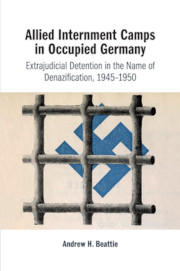 Allied Internment Camps in Occupied Germany
Allied Internment Camps in Occupied Germany Internment in Practice, 1945–1950
Published online by Cambridge University Press: 28 October 2019
Chapter 2 examines the practice of internment, from initial arrests through to the closure of the camps. It details how large numbers of internees were arrested through mandatory registrations, raids, or targeted or more random arrests. It then charts how, and how quickly, they were categorized, processed, and released or transferred to another status. The chapter shows that the western powers began releasing significant numbers in 1946, whereas the Soviets did not until 1948. Nevertheless, the chapter argues that the nature and even the speed of internees’ processing differed less than is often assumed. In all zones, internment was distinct from formalized denazification procedures and only a small proportion of internees were tried for individual crimes. Many more were released through administrative processes and various amnesties, often for political reasons. Soviet processes differed primarily in not affording internees opportunities to plead their case or defend themselves with due process. The chapter’s final section confirms the importance of political and broadly defined security considerations in the western zones by discussing the treatment of internees and their families in the context of French deportations from the Saarland in 1946–7 and a British settlement for ‘dangerous’ militarists and Nazis in 1947–8.
To save this book to your Kindle, first ensure [email protected] is added to your Approved Personal Document E-mail List under your Personal Document Settings on the Manage Your Content and Devices page of your Amazon account. Then enter the ‘name’ part of your Kindle email address below. Find out more about saving to your Kindle.
Note you can select to save to either the @free.kindle.com or @kindle.com variations. ‘@free.kindle.com’ emails are free but can only be saved to your device when it is connected to wi-fi. ‘@kindle.com’ emails can be delivered even when you are not connected to wi-fi, but note that service fees apply.
Find out more about the Kindle Personal Document Service.
To save content items to your account, please confirm that you agree to abide by our usage policies. If this is the first time you use this feature, you will be asked to authorise Cambridge Core to connect with your account. Find out more about saving content to Dropbox.
To save content items to your account, please confirm that you agree to abide by our usage policies. If this is the first time you use this feature, you will be asked to authorise Cambridge Core to connect with your account. Find out more about saving content to Google Drive.